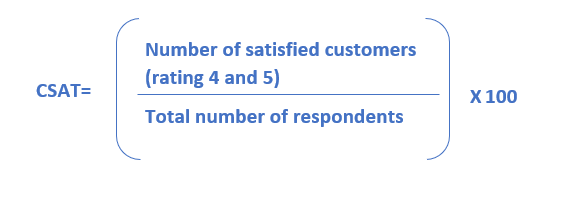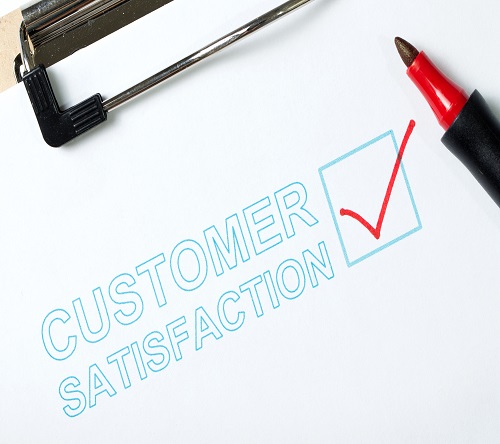
Table of contents
For the longest time, businesses viewed customer satisfaction as a one-off event rather than a process. The customer bought something from you, paid for it and the transaction is complete. Over the last few decades, the concept of customer satisfaction has evolved into a much more fluid concept. It also seems harder to achieve for a lot of companies.
Today, customer satisfaction is about how well your product or service meets – or even exceeds – the customer’s expectations. Most companies’ goals will include some variation on the theme of improving customer satisfaction.
But why does it matter if your products satisfy customers or not? How important is customer satisfaction anyway?
Why should you focus on customer satisfaction?
Consider what happens when a customer is dissatisfied with your product. Dissatisfied customers don’t just stop buying from you, they tell others about their bad experiences. Before the advent of social media, it meant they would tell their friends and family members. Today’s customers can reach hundreds, thousands, and even millions of other people through social media.
A viral story on dissatisfied customers can easily damage your brand, resulting in loss of trust and customers leaving in droves. You lose the opportunity to retain satisfied customers who are more likely to buy from a competitor. The negative publicity can lead to revenue losses and hit your bottom line.
On the flip side, a consistent service experience creates a satisfied and loyal customer base. With a little prompting, satisfied customers will also spread the word about your products and services to others online. Since many people treat online reviews as if they are personal recommendations, this is the best form of free marketing possible for your brand.
Word of mouth is viewed as more credible and trustworthy than most other advertising methods. With satisfied customers, you launch a positive cycle that brings in more loyal customers, improves brand value, and fuels business growth. The business will also save on the costs involved in acquiring new customers as these people already know about your product and have recommendations from their trusted friends/family.
Measuring customer satisfaction – Key Performance Indicators (KPI)
Improving custom satisfaction is crucial in the social media age. But how do you create an action plan if you don’t know where to begin? One of the key steps in achieving any goal is measurement. You need some metrics to show where you started, the progress achieved, and where you want the business to go.
Measuring customer satisfaction may seem daunting especially when customer expectations differ between industries, markets, and products. However, there are a few useful KPIs to measure this nebulous concept.
Net Promoter Score (NPS)
The Net Promoter Score is an important metric to reach the goal of improving customer satisfaction. The NPS tracks promoters and detractors, allowing a business to see if they have a loyal customer base.
Calculating NPS starts by asking customers a single question: ‘How likely are you to recommend the business/product/service to others?’ Customers answer by way of selecting a number from 1 – 10, with 1 is not likely and 10 is very likely. Depending on their rating, you categorize customers into:
- Promoters scored at 9 or 10, these are loyal customers who will recommend you to others
- Passives scored your business at 7 or 8 and they are neutral, vulnerable to competitor’s offerings
- Detractors respond with anything below 7, they are not likely to buy from you again and will also discourage others from doing so
Your NPS score is the percentage of promoters less the percentage of detractors. It can range from -100 (everyone is a detractor) to +100 (everyone is a promoter). There’s nothing complicated about NPS and it gives you a way to track customer sentiment over a period of time for your business or even individual product lines.
Customer Satisfaction Score (CSAT)
Similar to NPS, the Customer Satisfaction Score is a way to measure customer satisfaction through customer responses to one question: ‘How do you rate your overall satisfaction with business/product/service?’ Customers respond with a rating between 1 to 5, with 1 being very unsatisfied and 5 being very satisfied. The CSAT is usually expressed as a percentage and you calculate the score using the following formula:
If you have 1000 customers and 650 responded with a 4 or 5, then your CSAT score is 65%. Some businesses ask multiple questions in the same CSAT survey but usually, the norm is 1 question that attempts to capture the customer’s view of a particular interaction.
Most brands use CSAT to measure customer satisfaction with a particular interaction or transaction, rather than the complete customer experience. For example, you may calculate the CSAT score for your call center by asking the question immediately after a service/support call. You know you are doing well if your CSAT moves steadily higher.
Customer Effort Score (CES)
The Customer Effort Score is an indirect metric to measure customer satisfaction. While CSAT focuses on how satisfied your customers are, CES refers to the ease of doing business with your company. You will ask a single question from customers, right after a particular action such as buying a product or contacting support. A good example of a CES question would be ‘How easy was it to order XYZ/get support/subscribe to service?’
Customers respond by selecting one option between very easy to very difficult, usually 5 options are used. You will then calculate the average to determine if customers find it easy or difficult to interact with your company. If more customers say it was difficult to place an order or get support, then you need to streamline that particular process.
As you can see, both the CES and CSAT are metrics that capture transactional events and short-term effects. Both scores can vary between interactions, departments, and product lines. You can also measure the effects of small changes such as updating your online ordering process by comparing the CES before and after the change.
On the other hand, NPS is a long-term metric. Respondents are not rating a particular interaction, but rather the brand as a whole. Customers are more likely to recommend a brand they trust and will not stick to a brand they don’t trust. While CES and CSAT scores help you to improve specific processes, NPS is a good indicator of your overall progress in improving customer satisfaction.
How to improve customer satisfaction
Any action plan to improve customer satisfaction should have the following 4 steps:
Collect feedback
The easiest way to find out what you’re doing wrong is to ask your customers. Consumers who have had negative experiences are more likely to tell their friends about it, so you can take advantage of that impulse to get feedback on how your brand can do better. There are many ways to solicit feedback, based on what you are trying to improve.
For instance, suppose the CSAT score for online ordering is very low and you want to improve it. Consider asking for feedback right after someone orders something from your website. You can redirect them to a page with the survey questions or email it within a few hours while the experience is still fresh in their minds.
For support calls over the phone, ask customers if they would like to leave feedback by staying on the line after the interaction. Your staff can hand out feedback forms for in-person services or if you have a retail store. You can even text surveys to customers, making it even more convenient for them to answer your questions. Remember the less effort it takes to provide feedback, your customers are more likely to do it.
Act on feedback
It’s not enough if you simply collect feedback and store the data somewhere. You have to do something about it. Once your staff has collected, organized, and analyzed the feedback, create actionable items that you can implement. Assign teams to develop solutions and solve the pain points pointed out in the surveys.
Here are a few examples:
- Too much wait time for phone support
Analyze the reasons behind the long hold times. Is it because you don’t have enough people on the phones or agents lack training and need to get managers to solve customer issues? Organize training sessions or hire more agents.
- The website is too slow
Customers are more likely to view your website on a phone or tablet than on a full-size laptop. It means you need to optimize your site to run in less than ideal conditions such as slow internet speeds, smaller screens, and distracted users. There are many ways to speed up website loading and streamline the order process.
- Not enough training or help guides
Now more than ever, customers don’t have the time to sign up for training sessions or wait for a demo of a new product. They expect to find tutorials and videos online. So try creating a self-service portal for customers to learn about their new purchases.
- No way to chat with an agent on the website
While phone support remains the most popular support channel, many customers prefer instant messaging or a chat window online. If you don’t already have such a service, it’s definitely time to add one.
Make improvements
Once you have developed solutions or resolved outstanding issues, put them into action. Give customers some time to experience the changes and get used to them. Some resolutions are quick fixes while others may take weeks or months to implement. You may also want to split bigger projects into manageable phases and measure progress periodically.
Suppose you need to overhaul the company website but you don’t want to disrupt the customer experience. Try to focus on one area at a time such as online ordering, customer portal, training center, support center, etc. This way the entire website is not slow or down for all customers at once.
Communicate with customers
Make it a point to follow up with customers when you collect feedback and implement solutions. You want your customers to know you listened to their opinions and made changes based on them. If it’s an issue that many people have complained about, you can include the improvements in a newsletter or other periodic communication. If you have updated a process based on one particular review or opinion, reach out and let them know! Invite them back to try the new website or improved service and solicit feedback on the new system.
Enhance the customer experience
When trying to improve customer satisfaction, it’s important to consider the customer experience. Whether your customers purchase online or come into a store, whether they call you on the phone or request support via email, the experience should meet or exceed their expectations.
Set expectations
If customer satisfaction is about meeting or exceeding expectations and you’re falling short, the first thing to consider is if you’re setting the right expectations. Are your salespeople overpromising in an effort to close sales? Is your advertising/marketing campaign setting unrealistic standards for service?
Take the example of a 30-day guarantee, no questions asked. If customers have to fill out a form, provide ID and contact info and wait 3 weeks when trying to return purchases, then you’re not really honoring that guarantee. Catchy slogans are all very well but make sure to set realistic expectations when it comes to your products and services.
Consider all touchpoints
Back in the day, customers could contact a business via phone or in-person. Today’s customers expect multi-channel support over phone text, website, online chat, social media platforms, and even video. It’s up to businesses to ensure customers have a consistent and coherent experience across all channels, regardless of where a ticket originated. A customer should be able to call for help, follow up with an email, and track progress on their mobile app. In many ways, it’s better to delay adding a particular channel than provide a sub-par experience for users.
Social media strategy
Whether or not you offer support through social media, every business should have a presence on major platforms. The platforms you use will depend on your audience such as organizations, teenagers, retirees, etc. Your social media strategy has to be tailored to the brand and your overall messaging. Is your brand viewed as fun, luxurious, aspirational, or serious?
Social media platforms help you reach more people and personalize communication but one small mistake can easily snowball into a major crisis. Make sure you have the right team in place to manage all the various platforms you’re on. The best way to fix mistakes is to acknowledge them, make apologies, and make sure you don’t repeat them.
Be proactive
Thanks to real-time communication channels like social media, video, and instant messaging, customers expect brands to be proactive. It means companies have to move beyond reactive processes and proactively manage the customer experience. For instance, instead of waiting for customers to review their purchase, you encourage them to do so via email or text. Don’t wait for customers to complain about long hold times and hire more agents when your call volume increases and so on.
Treat your employees well
Your employees play a big role in the overall customer experience. When someone calls into your support center, they talk to an agent. When a potential customer walks into your store, a staff person will serve them. If your employees are not trained or feel underappreciated, they cannot provide best-in-class service for customers. Make sure your staff knows what is expected of them and empower them with the right tools so they can serve customers well.
Provide self-service options
In today’s digital age, customers expect businesses to offer self-service options for support. Depending on what kind of products and services you offer, make sure you have a customer portal with relevant guides, videos, manuals, and other helpful resources. Links to your website, contact information, and support options should be clearly labeled and visible so customers can find more help when they need it.
Call centers
In spite of the proliferation of social media platforms, phone calls remain the most popular means of getting support. Even a small business needs a robust phone system to handle support calls, service questions, and to answer customer queries. Bigger organizations often invest in advanced call center systems to ensure callers get the possible experience and help them manage high call volumes.
Optimizing your call center is often the best way to improve customer satisfaction. There are several parameters you need to keep an eye on:
- Hold times – are customers waiting for a long time to speak with an agent? Do agents put them on hold while trying to find answers?
- How often do customers hang up before someone answers their call? Do customers frequently get directed to voicemail instead of talking to an agent?
- What is your resolution rate for calls? Do customers keep calling in for the same issues several times?
- Does your phone system fail or stop working frequently preventing agents from answering calls? Are all your systems integrated with each other?
- Can agents transfer calls to another department or person correctly? Do customers get transferred multiple times for the same issue?
Not all call centers deal with the same kind of calls and some metrics will differ based on audience, industry type, products, and services. For instance, the contact center for a retail store will handle different types of calls than the support line for a hospital. Fast response times for a hospital are vital as they deal with life and death issues but first-call resolution may be more important for a hotel chain. Every business needs to consider its goals and how to optimize its phone systems to improve customer satisfaction.
Differences between B2B and B2C customers
Perhaps the biggest difference in the customer experience is between B2B and B2C companies. Businesses that cater to other organizations (business to business) will have a different customer strategy than brands that cater to individual consumers (business to customers).
Some major differences between B2B and B2C firms include:
-
B2B firms have fewer clients but bigger contracts
A B2B firm may have only hundreds or even thousands of clients compared to several million for a similar-sized B2C business. It means your phone system will handle fewer calls but resolving issues satisfactorily is more important. If a customer interaction goes badly, you may be risking a business relationship spanning years or lose a multi-million deal.
-
B2B companies typically deal with more complex issues
B2B products and services tend to be highly specialized and technical. It means when customers call about an issue, it’s more likely to be a complex one and needs several calls to resolve. Therefore first-call resolution may not be a good metric for them but having highly trained agents is more important.
-
B2C organizations use more social media
B2C companies generally use social media to provide support for their customers but B2B firms tend to rely more on email and phone. Business clients sue your products and services in their workplace, so a social media presence is less vital for customer satisfaction.
-
B2B companies know their customer
B2B companies tend to know their clients better than B2C customers with millions of users. A firm will have a long-term relationship with its clients and has a history of previous interactions. These clients also expect a more personalized experience than the average consumer. So cultivating these business relationships is more important than any particular transaction.
As you can see, optimizing your phone system is about more than selecting the right phone or headset. Improving customer satisfaction means thinking of every aspect of the service experience from the first time a potential customer searches for your product to after-sales service and beyond. Your call center or phone system is a big part of the puzzle and optimizing it may mean the difference between a good or bad customer satisfaction score.
More from the blog
Want to improve your business communication?
Unlock enterprise-class call center power at affordable prices – no hardware, no delays, no surprises!









